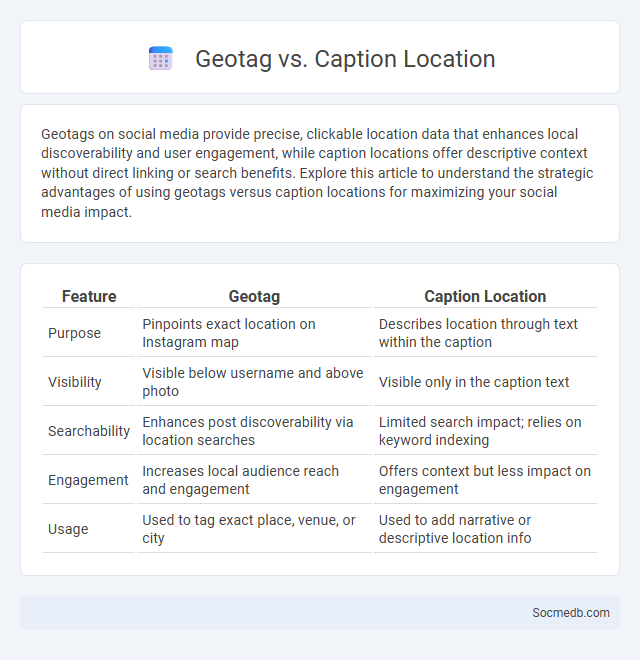
Photo illustration: Geotag vs Caption Location
Geotags on social media provide precise, clickable location data that enhances local discoverability and user engagement, while caption locations offer descriptive context without direct linking or search benefits. Explore this article to understand the strategic advantages of using geotags versus caption locations for maximizing your social media impact.
Table of Comparison
| Feature | Geotag | Caption Location |
|---|---|---|
| Purpose | Pinpoints exact location on Instagram map | Describes location through text within the caption |
| Visibility | Visible below username and above photo | Visible only in the caption text |
| Searchability | Enhances post discoverability via location searches | Limited search impact; relies on keyword indexing |
| Engagement | Increases local audience reach and engagement | Offers context but less impact on engagement |
| Usage | Used to tag exact place, venue, or city | Used to add narrative or descriptive location info |
Understanding Geotags: Definition and Purpose
Geotags are metadata embedded in social media posts that include geographic coordinates such as latitude and longitude, enabling precise location identification. These tags help users discover content relevant to specific places and enhance local marketing strategies by targeting audiences based on location. Businesses leverage geotags to analyze consumer behavior patterns and increase engagement through location-based promotions.
What Is Caption Location?
Caption Location refers to the specific section within a social media post where the descriptive text or message is placed, often accompanying photos, videos, or other content. It plays a crucial role in enhancing user engagement by providing context, storytelling, or calls to action directly below or beside the visual media. Optimizing Caption Location improves content visibility in feeds, boosts interaction rates, and supports platform algorithms in categorizing and promoting posts.
Geotag vs Caption Location: Key Differences
Geotag and caption location serve different purposes in social media posts; a geotag embeds precise GPS coordinates, allowing platforms to map your exact location, enhancing discoverability through location-based searches. In contrast, a caption location is a text-based mention that adds context or storytelling without linking to specific geographic data. Understanding these distinctions helps you optimize engagement by leveraging accurate spatial metadata through geotags or personalized narratives via caption locations.
How Geotags Enhance Content Discoverability
Geotags play a crucial role in increasing your social media content's visibility by linking posts to specific locations, making them easier to find through location-based searches and trending tags. By adding geotags, your content reaches a targeted audience interested in that area, boosting engagement and expanding reach beyond your immediate followers. Incorporating geotags strategically improves discoverability and helps position your brand or profile in relevant local and global conversations.
The Role of Caption Location in Social Media
Caption location significantly impacts user engagement on social media platforms like Instagram and Facebook, with captions placed directly below images generating higher interaction rates. Strategic positioning enhances content discoverability and readability, influencing how followers perceive and interact with posts. Effective caption placement can boost brand visibility, increase comment frequency, and improve overall post performance in social algorithms.
Accuracy: Geotagging vs Caption Location
Geotagging offers precise, automated location data embedded in your social media posts, ensuring accurate representation of where content was created, unlike caption location which relies on manual input and can lead to inconsistencies or errors. Using geotags enhances the credibility of your posts by providing trustworthy location verification that benefits local businesses and event promotions. Your audience gains a reliable sense of place, improving engagement and trust with your content.
Privacy Considerations for Geotags and Location Captions
Geotags and location captions on social media can expose Your exact whereabouts, increasing risks of privacy invasion and unauthorized tracking. Adjusting privacy settings to limit who can view Your geotagged posts helps prevent potential misuse of location data. Being mindful of when and where You share location information enhances Your online security and privacy protection.
Impact on SEO: Geotag vs Caption Location
Geotags in social media posts enhance local SEO by directly associating content with specific geographic locations, improving visibility in location-based searches. Caption locations provide contextual relevance through keywords, which support search engines in understanding the content's thematic connection to a place. Combining geotags and accurate caption locations maximizes SEO impact by bridging precise local signals with rich textual context.
Best Practices for Using Geotags and Caption Locations
Using geotags and caption locations on social media enhances the visibility of your posts by connecting them to specific places, attracting local audiences and increasing engagement rates. Incorporate relevant, popular locations to optimize discoverability while ensuring the tags align authentically with your content to maintain credibility. Your strategic use of geotags can boost interactions, improve content reach, and support brand storytelling through geographic context.
Which Should You Use: Geotag or Caption Location?
Choosing between geotags and caption locations depends on your social media goals and audience engagement. Geotags enhance discoverability by associating your posts with specific locations, increasing visibility in location-based searches, while caption locations offer a more personalized storytelling element. You should use geotags to boost local reach and attract nearby users, and caption locations to add context and connect emotionally with your audience.
 socmedb.com
socmedb.com